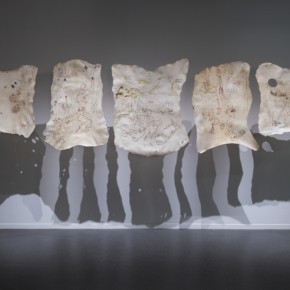
Installation view of Jerry Ropson’s “as spoken in tongues,” Steve Topping’s “Floating Table” and Janice Wright Cheney’s “Coy Wolves” at The Rooms, St. John’s, NL.
If there’s one thing sure to incite panic in this art reviewer, it’s being faced with the task of encapsulating the eleven works which comprise Folklore And Other Panics, a group exhibition at the Rooms Provincial Art Gallery in St. John’s, in a twelve hundred word piece without giving short shrift to a given artist’s contribution, but, for the sake of writing a decent piece (not to mention my sanity) I’ve decided against that particular tack. As for folklore, when I hear that word I usually think of how, back in like, 1998, hacking darts with buddies in the shadow of the library at Memorial University, a pal who was majoring in said field of study let me know that what we were doing just then (that is, hacking darts, chatting et cetera), was pretty much THE definition of folklore, and furthermore, was how culture itself was formed.
Strolling through the exhibition, that conversation was on my mind. Curator Mireille Eagan seeks to address what she calls “folklore stereotypes”—the perhaps worn duality of art world outsider versus insider—and that old chestnut of Newfoundland (not to mention Canadian) art production: the romanticized landscape. Eagan points out that “the notion of panic is a construct of popular culture; nearly 50 years of evidence shows that people rarely panic in crisis situations.” Folklore And Other Panics addresses the impossibility of “alleviating anxiety around elitism” in the contemporary art world. And further, according to the exhibition’s pamphlet, “the works provide a constellation of ideas, responding in various ways to themes of absence and presence, community, the materials of storytelling, and the nature of authority.”
The notion(s) of absence/presence is in the forefront, augmented through Eagan’s museological display. Kay Burns’ work, created under the pseudonym, Iris Taylor, is the first you see upon entering the gallery and consists of two flattened globes—the stomping of which is an initiation into her Flat Earth Society, the group whose mandate consists of promoting free thinking and debate. The first flattened globe belongs to Iris, who was “born” in 2003 aged somewhere in her 50s, and one Bartholomew Seeker, the mysterious and seemingly likewise fictional character who, Burns claims, simply disappeared in 1978.
An extension of the Flat Earth Society’s criticality toward assumed knowledge, this fiction within a fiction within a fiction within an art practice demonstrates Burns’ adversarial stance toward the dominant narratives through which our history and knowledge are formed. And it’s funny, too.
Similarly, Steve Topping’s Floating Table is a kind of artifact which makes reference to a complex narrative belied by its simple appearance. What that narrative may be I’m not entirely sure, given a) the number of times, utterly blotto, I’ve sat at that table, joking, talking and playing cards with Steve and a slew of others over the years, and b) that the drawings, writing and other marks on the table’s surface have worn away to varying degrees of illegibility. What I do know is that this table was Topping’s primary piece of furniture at what is called The Stage, a derelict fishing stage clinging to the rocks near St. John’s harbour where the artist lived during the spring and summer months.
With a practice that “takes into account alternative urban and rural living spaces” Topping’s piece represents a myriad of stories: his own travel to Newfoundland and eventual residence at the Stage, the numerous visitors to that site, and the development of a small yet vital community of artists (visual and otherwise) in the province and beyond. Like the table itself, our personal histories, folklore, narratives and so on are formed haphazardly, riddled with do-overs, erasure, mistakes, ad-hoc improvisations and wear until such point that we can say that rather than being “finished” or “complete,” they are just as they are, as it were. That is, until such point that the object in one case, and our self in the other, ceases to exist.
Joshua Bonnetta’s Strange Lines And Distances (2012) is a dual channel HD (from 16 mm film) projection inspired by Guglielmo Marconi, the Italian inventor and engineer who famously sent the first trans-Atlantic radio signal from Cornwall, England, which was received—where else?—at Signal Hill in St. John’s on December 12, 1901. Says the artist: “I came across several accounts that Marconi had a desire to listen to the past—the story goes that he thought sound waves never disappeared but just grew incrementally fainter, and that if you had the technological means you could listen to traces of past events.”
For Bonnetta, this desire of Marconi’s, while scientifically probably impossible, nevertheless led him to record audio from both sites, listening for what he calls “intimations of something hidden in the static and noise.” The results—along with two 16mm films shot from location, one camera facing toward Cornwall, the other, toward St. John’s—make up the installation for the show.
So there’s landscape for you, 3455 miles of vast, bleak Atlantic ocean where there’s nothing but death by drowning or else, oblivion. Listening to Bonnetta’s static, I couldn’t help but think of Bas Jan Ader’s In Search of the Miraculous—either a preposterous gamble or elaborate suicide—who knows?—and of how Bonnetta’s piece so elegantly describes not just the fool’s errand of artistic endeavour, but the “panic” of living in the face of certain doom. His work addresses how desperately we seek to find meaning in the chaos of existence, the process by which we create our culture.
Note: Folklore And Other Panics (on view: January 17 – April 26) includes works by several other artists, including: Michael Waterman, Michael Flaherty, Mark Clintberg, Jerry Ropson, Lee Henderson, Janice Wright Cheney, Duane Linklater, and Kym Greeley & Erika Jane Stephens-Moore.















Leave a Reply